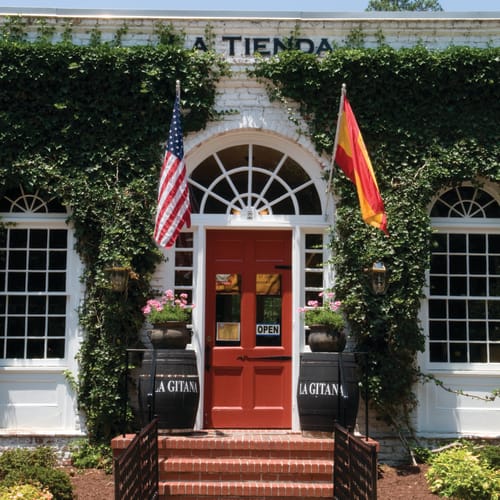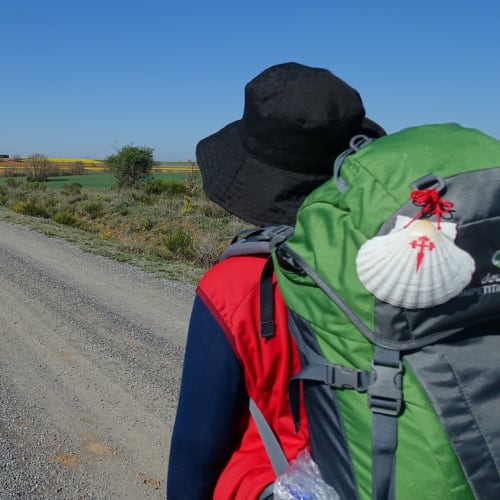Flags and Family
Don Harris | July 2011




We have a young houseguest, Ibon, who is a 16 year old student from the Basque Country. So this year the Fourth of July was an extra special day for us because of his visit. During his brief stay with us, he hopes to brush up on his English (he already speaks Basque, Spanish and French!) and get the flavor of American life. His parents, Sebastian and Mila are friends of ours who provide La Tienda with some of our finest Bonito del Norte tuna.
Ibon arrived in the last days of June, so Independence Day was his first exposure to true Americana. The Fourth of July is the most American celebration of them all – complete with parades, speeches, fireworks and hamburgers and hot dogs on the patio grill. It also marks the midway point of the Major League Baseball season, ‘America’s pastime.’
As you can imagine, our hometown Williamsburg, the historic city of the American Revolution, made every effort to celebrate its heritage. The Capitol and the Governor's Palace were the center of the political and social life of Virginia for most of the 18th century. George Washington and Thomas Jefferson were students at the College of William & Mary. Patrick Henry, while serving in the legislature, launched impassioned patriotic speeches from this city.
Like most of the towns in the United States on the Fourth of July, Williamsburg was dressed up in red, white and blue: buntings, t-shirts, bands, balloons and of course the ‘Stars and Stripes.’ The American flag, affectionately called ‘Old Glory,’ was everywhere, lining the streets and buildings of Williamsburg.
The Fifes and Drums Corps proudly marched down Duke of Gloucester Street in their 18th century apparel. It is composed of boys and girls who begin their education in military music at age 10 and practice weekly for the next eight years, until after they have graduated from high school. Alongside them was the Color Guard from the local naval base. Local leaders made patriotic speeches and the celebration was crowned by a fireworks display of epic proportions, which drew thousands of people from hundreds of miles away.
Because Ibon was with us, my wife and I had a chance to experience the celebration through the eyes of a person from quite a different culture. Of course, Ibon has enjoyed fireworks and parades before, since they are a part of ferias at Ibon’s home in the Basque Country. What he saw as unique to our celebration was the presence of so many American flags. They were everywhere.
I think he is right. I do not remember the national Spanish flag as the centerpiece of a national event in Spain, much less displayed in front of private homes as it is in the United States. When the national ensign appears at a public celebration, it is paired with the flag of the autonomous region. The flag of Castilla-León with its checkerboard of rampant lions and solid castles; the deep red flag of Pais Vasco with its intersecting green and white crosses, or the proud flag of Asturias with the fabled cross of Covadonga emblazoned on a sky blue field are of equal or primary importance to the local people.
There are two national observances in Spain which I think might be roughly equivalent to the American Fourth of July. One is the Feast of Santiago, the patron saint of Spain, celebrated on July 25th; the other is El Dia de Hispanidad with the primary site of celebration at the Basilica of Nuestra Señora del Pilar in Zaragoza. Both celebrations are anchored on the sites of saints who, in effect, become the national heroes.
Many years ago, my wife and I were in Santiago de Compostela for the Patronal Feast of Santiago (Saint James). Because July 25th fell on a Sunday, the year was the culmination of a Holy Year. We traveled to this hallowed Galician city to meet our son Jonathan, who was just arriving from a two-month walk from France across Spain along the Camino de Santiago – a route along which hundreds of thousands of pilgrims have traveled over the ages. All the pilgrims have a cockle shell on their walking staff, hat or shirt as a symbol of St. James. It is the same shell that we chose for the logo of LaTienda.com.
The three of us were standing shoulder to shoulder with thousands of other people in the Plaza de Obradoiro in front of the Cathedral. King Juan Carlos and Queen Sofía were there along with dozens of cardinals and noted dignitaries. Our attention was focused on a remarkable ‘light show’ which depicted the sacking of the city by the marauding Moorish warriors of Al-Mansur: bigger than life figures on horseback flashed across the facade of the cathedral. Clearly the common denominator on that national holiday was the pilgrimage tradition of the Camino, and the commemoration of the 700 century struggle of the Christians to rid the peninsula of foreign forces from Africa and as far away as Damascus. The national flag was almost an afterthought.
On another occasion, Ruth and I witnessed the celebration of Dia de la Hispanidad in Zaragoza. Although it was a national holiday and all government buildings were closed, the focus was on the Virgin of Nuestra Señora del Pilar. All week long there was a stream of villagers from Aragón and beyond headed to the basilica. Along the way, some were dancing the jota and other local dances. Their destination was the Basilica of Our Lady of Pilar where they contributed armfuls of fresh flowers to the mounting pyramid of bouquets lain at the feet of the Virgin. The King of Spain attended, as in Santiago, but again, the focus was not on the national identity represented by the monarch or the flag, it was rather on the age-old religious tradition passed on over a millennium.
This is quite a different setting than our national day in America. Other than among indigenous people, we cannot draw upon thousands of years of tradition as the Spanish can. We have nothing like a friend of mine in Spain whose family first settled in his hometown more than 800 years ago! What we Americans hold in common is that we are all from somewhere else. Within my conservative little city live neighbors of many traditions: Chinese, English, Spanish, Greek, Vietnamese, Korean, Romanian, Indian and more. Our forbearers came here because they wanted to make a better life, seeking the freedom to shed the past and start anew.
Essentially, on the Fourth of July we Americans celebrate an ideal expressed on our national seal: ‘E Pluribus Unum’ – out of many, one. Our experiment in democracy has been lived out over just a relatively few centuries – and for some of us it is just a few years since we came to these shores. This is why our ‘Star Spangled Banner’ is of singular importance to us – with fifty stars on a field of blue and the thirteen stripes of the founding states.
The people of Spain and the United States have been molded by radically different experiences, and these are reflected in the form of our national celebrations. Nevertheless, we are no different when we marvel at the fireworks with our grandchildren. We are all one in our desire to love and be loved, to build solid families and prepare a good future for our children. Ruth and I are enriched every time we return to Spain and enjoy the hospitality of the many traditional families who provide to La Tienda the work of their hands. Moreover, we hope our young house guest from Spain will gain from his experience of living among Americans for a few weeks, sharing our daily life.
Su amigo,
Don

